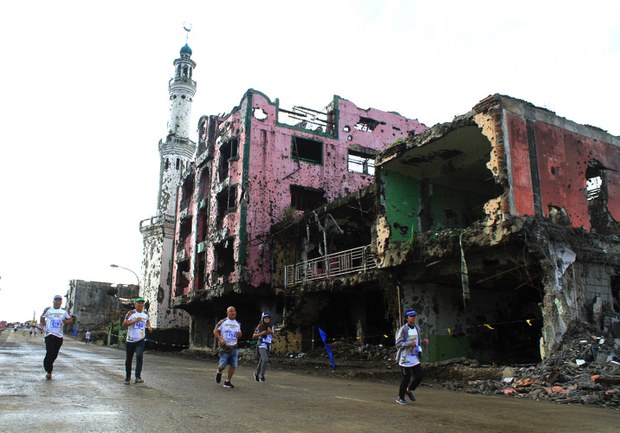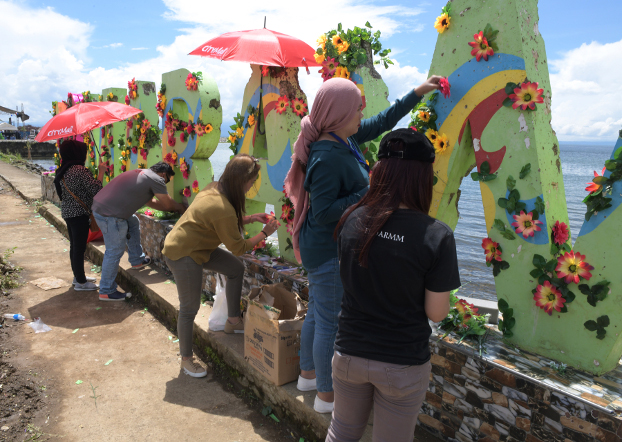Two Years On: Displaced Marawi Residents Face Bleak Future
2019.10.17
Marawi, Philippines
 Runners join a “fun run” fundraiser in the ruined commercial district of Marawi, where Islamic State-linked militants engaged Philippine security forces in vicious firefights two years ago, Oct. 17, 2019.
Runners join a “fun run” fundraiser in the ruined commercial district of Marawi, where Islamic State-linked militants engaged Philippine security forces in vicious firefights two years ago, Oct. 17, 2019.
Two years after Philippine security forces chased out remnants of an Islamic State-linked group from the southern city of Marawi, thousands of residents say they face a bleak future amid the government’s slow work to bring them back home.
An earth-mover shakily tore down ruined buildings as members of the government’s Task Force Bangon Marawi (“Rise Up Marawi”) escorted journalists around empty streets where little has changed in the past two years.
Officials blamed the slow clearing operations on unexploded ordnance that dot the ruins of Marawi. On Wednesday, troops detonated a 250-kilogram (550-pound) bomb they found in the area.
The task force, an inter-agency group created to supervise the city’s recovery, had promised that displaced residents would be allowed to return to their villages and rebuild their homes in May this year, a deadline that was extended to September.
But carting away debris from the battleground of a vicious war has been an agonizingly slow process, observers said. That area – the ground-zero of fighting that the government calls Most Affected Area – is littered with concrete slabs and charred sheet metal.
“We do not feel we were liberated,” Norhaisah Radja-alam, 36, told BenarNews. “After two years, we are still living inside temporary shelters so small that it barely fits my family of nine.”
Food donations from international NGOs and the government ran dry more than a year ago, she said. Radja-alam’s family has had to scrape by. To survive, she sells food to her neighbors in the relocation shelter, earning about 200 pesos (U.S. $4) a day.
“We also eat the food we sell, and from its earnings, buy the food we will cook for the next day,” Radja-alam said.
Cramped housing
Norhayne Dimapinggun lives with 16 members of her family inside a 24-square meter house in the village of Sagonsongan, one of the relocation sites near Marawi City.
She said the space was so tiny that she built a small extension at the back, using 75,000 pesos ($1,500) in livelihood funds the government gave her a year ago.
Dimapinggun said she missed the family’s ancestral compound inside the city where many of her relatives grew up.
“Our compound had three to four houses where about 50 of our relatives used to live,” she said. “It was a happy place every day.”
Dimapinggun said they all relied on one another in both happy and bad times, a kind of support system that kept the family together until fighting began in May 2017.
Philippine security forces were about to arrest Isnilon Hapilon, a leader of the local extremist group Abu Sayyaf who had emerged as the regional “emir” of IS, when they were surprised by fierce resistance from the Marawi compound where he was located.
Five months of fighting, punctuated by almost daily bombing runs by fighter jets, pounded the once-scenic, mosque-studded city and killed more than 1,200 people, most of them militants, including Hapilon and his top aides.
Dimapinggun said her family has scattered in the nearby cities of Iligan and Cagayan de Oro, and as far away as Manila, the Philippine capital, about 1,200 km (760 miles) north of Marawi.

Fighting destroys families
Dimapinggun’s story underscores one of the major casualties of the Marawi war: family bonds.
The clashes ripped apart tight-knit families and shattered crucial support systems, said Ellen Anisha Guro, head of Mindanao State University library in Marawi.
“Residents here are clannish and rely on each other for comfort and support,” Guro told BenarNews, emphasizing that the design of temporary shelters built by the government did not consider local culture.
“A new house owner finds himself not in a neighborhood of family members but a community of strangers,” Guro said.
Father Teresito Soganub, a Catholic priest who was taken hostage by the militants for weeks, told BenarNews the government may have failed to see that the war not only physically destroyed the city, but ruptured the way of life for its residents.
“What is the use of new homes and buildings?” he said. “For the residents here, their family is more important.”
The siege took place over several months beginning in May 2017. Hapilon was backed by Southeast Asian and Middle Eastern fighters who beheaded locals who resisted them, took over homes and held many hostage.
President Rodrigo Duterte later sought help from the United States and Australia, which provided aerial surveillance to defeat the IS-linked fighters, though some of them escaped as security forces clobbered the city with aerial bombings.
Fighting ended soon after the government announced the death of Hapilon and his top lieutenants. Marawi was liberated, although large, ancestral areas were destroyed.
The city’s more than 200,000 residents who fled the fighting remain in evacuation centers two years later.
Duterte promised to rebuild Marawi City; China, Russia, Japan and the United States pledged money to support the rehabilitation. But those financial promises have not materialized, reports said.
Few dollars have reached the demolished areas. Meanwhile, according to estimates, the government would need to pour in up to $1.5 billion to rebuild.
But two years after the war ended, dreams of rebuilding have remained just that. Most residents who’ve lost their homes are now demanding compensation for their losses.
“There is nothing to commemorate, only pain and our sufferings that continue until today,” Drieza Abato Lininding, a former Marawi homeowner, told BenarNews.
“We don’t feel liberated at all,” he said.
![191017-PH-marawi-middle.jpg A Philippine Army platoon renders a gun salute as a sign of respect during the wreath-laying ceremony at the heroes’ landmark inside the 103rd Infantry Brigade headquarters in Marawi, Oct. 17, 2019. [Richel V. Umel/BenarNews]](/english/news/philippine/marawi-anniversary-10172019160724.html/191017-PH-marawi-middle.jpg/@@images/f8a7ac1d-1271-4c97-ba3d-51ae36ef8b6e.jpeg)








